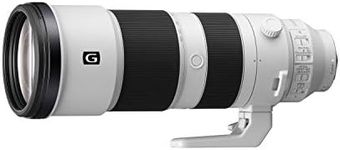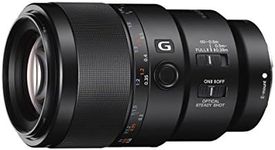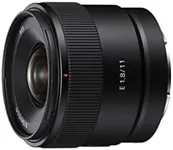We Use CookiesWe use cookies to enhance the security, performance,
functionality and for analytical and promotional activities. By continuing to browse this site you
are agreeing to our privacy policy
Best Sony Lenses
From leading brands and best sellers available on the web.#2

Sony
6%OFF
Sony FE 50mm F1.4 GM Lens (Sony E)
View Product
#3

Sony
Sony SEL2470GM FE 24-70mm F2.8 GM Lens (Black)
View Product
#4

Sony
Sony FE 50mm F1.2 GM Full-Frame Large-Aperture G Master Lens
View Product
#5

Sony
Sony Fe 200-600mm F5.6-6.3 G OSS Super Telephoto Zoom Lens (SEL200600G)
View Product
#6

Tamron
18%OFF
Tamron 17-70mm f/2.8 Di III-A VC RXD Lens for Sony E APS-C Mirrorless Cameras Black
View Product
#7

Sony
Sony FE 70-200mm F4 Macro G OSS II
View Product
#8

Sony
5%OFF
Sony FE 35mm F1.4 GM Full-Frame Large-Aperture Wide Angle G Master Lens
View Product
#9

Sony
7%OFF
Sony FE 20-70mm f/4 G Lens (Sony E)
View Product
#10

Sony
5%OFF
Sony E-mount FE 24mm F1.4 GM Full Frame Wide-angle Prime Lens (SEL24F14GM), Black
View Product
Buying Guide for the Best Sony Lenses
Choosing the right lens for your Sony camera is a crucial step in getting the best results from your photography or videography. Lenses have a huge impact on the look and feel of your images, and the right choice depends on what you want to shoot, your style, and how you plan to use your camera. Before buying, think about the types of photos or videos you want to create—whether it's landscapes, portraits, sports, wildlife, or everyday moments. Understanding the key specifications of lenses will help you make a choice that matches your needs and helps you grow as a photographer.Focal LengthFocal length, measured in millimeters (mm), tells you how 'zoomed in' your lens is and what kind of scenes it can capture. Shorter focal lengths (like 16mm or 24mm) are wide-angle, great for landscapes or architecture because they capture more of the scene. Mid-range focal lengths (like 35mm or 50mm) are versatile and often used for street, documentary, or portrait photography. Longer focal lengths (like 85mm, 135mm, or 200mm and above) are telephoto, ideal for portraits, sports, or wildlife, as they bring distant subjects closer. To pick the right focal length, think about your main subjects: wide for big scenes, mid for everyday use, and long for distant or detailed shots.
ApertureAperture is shown as an f-number (like f/1.8, f/2.8, f/4, etc.) and controls how much light the lens lets in, as well as how blurry the background can get. Lower f-numbers (like f/1.4 or f/1.8) mean a wider aperture, which is great for low-light situations and for creating a soft, blurry background (bokeh) in portraits. Higher f-numbers (like f/4 or f/5.6) let in less light and keep more of the scene in focus, which is useful for landscapes. If you shoot a lot in dim light or want strong background blur, go for a lens with a lower f-number. For general use or landscapes, a higher f-number is often fine.
Lens Mount CompatibilityLens mount refers to the physical connection between the lens and the camera body. Sony uses different mounts, with E-mount being the most common for their mirrorless cameras, and A-mount for some older models. It's important to make sure the lens you choose matches your camera's mount, or else it won't fit or work properly. Always check your camera's mount type and look for lenses designed for it. If you have an E-mount camera, stick with E-mount lenses for the best performance and features.
Image StabilizationImage stabilization (sometimes called OSS in Sony lenses) helps reduce blur from shaky hands, especially in low light or when using longer focal lengths. Some Sony cameras have stabilization built into the body, while some lenses have it built in. If you often shoot handheld, especially with telephoto lenses or in dim conditions, having image stabilization in your lens can help you get sharper photos. If your camera already has stabilization, this feature is less critical, but it can still be helpful for certain types of shooting.
Autofocus PerformanceAutofocus performance refers to how quickly and accurately the lens can focus on your subject. Some lenses have faster, quieter, or more precise autofocus motors, which is important for action, sports, wildlife, or video work. If you shoot fast-moving subjects or want smooth, silent focusing for video, look for lenses known for good autofocus performance. For slower-paced photography, like landscapes or still life, autofocus speed is less important.
Lens Size and WeightThe size and weight of a lens can affect how comfortable it is to carry and use, especially for long periods. Larger, heavier lenses can be tiring to hold, but they often offer better image quality or more features. Smaller, lighter lenses are easier to carry and less noticeable, which is great for travel or street photography. Think about how much gear you want to carry and how you plan to use your camera—if you value portability, go for a compact lens; if you prioritize performance, you might accept a bit more weight.
Weather SealingWeather sealing means the lens is built to resist dust and moisture, making it more reliable in tough conditions like rain, snow, or dusty environments. If you often shoot outdoors or in unpredictable weather, a weather-sealed lens can give you peace of mind and help protect your investment. For indoor or casual use, this feature is less critical.






